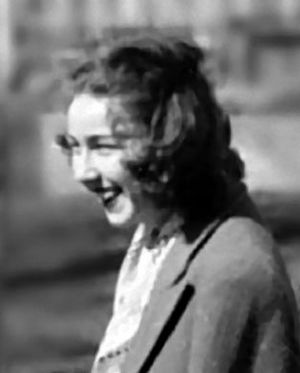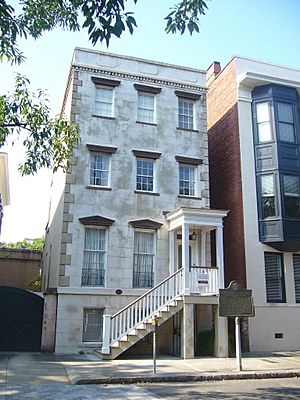Flannery O'Connor facts for kids
Quick facts for kids
Flannery O'Connor
|
|
|---|---|
 |
|
| Born | Mary Flannery O'Connor March 25, 1925 Savannah, Georgia, US |
| Died | August 3, 1964 (aged 39) Milledgeville, Georgia, US |
| Resting place | Memory Hill Cemetery, Milledgeville, Georgia |
| Occupation |
|
| Period | 1946–1964 |
| Genre | Southern Gothic |
| Subject |
|
| Literary movement | Christian realism |
| Notable works |
|
Mary Flannery O'Connor (born March 25, 1925 – died August 3, 1964) was an American writer. She wrote novels, short stories, and essays. She is known for her unique writing style, often called "Southern Gothic." Her stories usually took place in the American South.
Flannery O'Connor's writing often explored ideas about faith and what is right and wrong. Her book Complete Stories won a major award in 1972. Many people still praise her work today.
Early Life and School

Growing Up
Flannery O'Connor was born in Savannah, Georgia, on March 25, 1925. She was the only child of Edward Francis O'Connor and Regina Cline. Her family had Irish roots. She once described herself as a "pigeon-toed child" who liked to be left alone. Her childhood home in Savannah is now a museum.
In 1940, her family moved to Milledgeville, Georgia. They lived with her mother's family. Her father became sick with a disease called lupus in 1937. He passed away in 1941. Flannery and her mother continued to live in Milledgeville. Later, in 1951, they moved to Andalusia Farm, which is also a museum today.
Her Education
Flannery went to Peabody High School. She was the art editor for the school newspaper. She graduated in 1942. She then attended Georgia State College for Women. She finished her degree in sociology and English literature in just three years. While in college, she drew many cartoons for the student newspaper. Some people believe these early cartoons influenced her later writing style.

In 1945, Flannery was accepted into the famous Iowa Writers' Workshop. This is a special program for writers at the University of Iowa. She originally planned to study journalism there. At the workshop, she met many important writers and critics. One of them was Andrew Lytle, who later published some of her stories. The director of the workshop, Paul Engle, helped her with early drafts of her first novel, Wise Blood.
She earned her Master of Fine Arts degree in 1947. She stayed at the workshop for another year on a special scholarship. In 1948, she continued working on Wise Blood at Yaddo. This is a place where artists can go to focus on their work. She also wrote several short stories there. In 1949, she moved to Ridgefield, Connecticut, to stay with writer Robert Fitzgerald and his wife.
Her Writing Career
Flannery O'Connor is most famous for her short stories. She published two collections of them during her lifetime. These were A Good Man Is Hard to Find (1955) and Everything That Rises Must Converge (published after she died in 1965). Many of her short stories have been printed in important collections.
She also wrote two novels. They are Wise Blood (1952) and The Violent Bear It Away (1960). Wise Blood was even made into a movie. She also had other writings published, like essays and letters. Her work continues to be studied by many scholars.
Flannery's writing career showed a lot of growth. She started as a student writer. Then she published her first novel, Wise Blood. Later, she wrote A Good Man Is Hard to Find and The Violent Bear It Away. In her final period, she wrote Everything That Rises Must Converge. Her writing became deeper and more complex over time.
Her Writing Style
Flannery O'Connor's stories often took place in the American South. She said that anything from the South might seem "grotesque" to readers from other places. Her characters often had flaws or faced difficult situations. Sometimes they interacted with people with disabilities, or they had disabilities themselves. Race was also a topic that appeared in her stories.
Her stories often had disturbing parts. However, she didn't like being called "cynical." She said her stories were "hard" because they showed "Christian realism." This means she tried to show how God's grace can change people, even if it's a painful process. She believed that the world was filled with God's presence.
Flannery also had a sharp sense of humor. She often found humor in how her characters saw the world compared to what was really happening to them. She also used humor to show how some people struggled to understand the rural South. They often had simple ideas about disability, race, and poverty.
She explored important issues of her time. For example, she wrote about the Holocaust in "The Displaced Person." She also wrote about racial integration in "Everything That Rises Must Converge." Her stories often touched on racial issues in the South.
Even though she lived a quiet life, her writing showed a deep understanding of people. She gave many talks about faith and literature. She traveled quite a bit, even though her health was not strong. She supported civil rights and voted for John F. Kennedy.
Illness and Passing
In the summer of 1952, Flannery O'Connor was diagnosed with lupus. This was the same illness her father had. She lived at Andalusia Farm for the rest of her life. She lived for twelve years after her diagnosis, which was longer than doctors expected.
Her daily routine included attending church, writing in the mornings, and then resting and reading. Even with her illness, she gave over sixty lectures and readings of her work. A writer named Alice McDermott said that lupus might have made Flannery the writer she became.
Flannery O'Connor wrote more than two dozen short stories and two novels while living with lupus. She passed away on August 3, 1964, at the age of 39. She was buried in Milledgeville, Georgia.
Her Letters
Flannery O'Connor wrote many letters throughout her life. She wrote to other writers like Robert Lowell and Elizabeth Bishop. After she died, some of her letters were published in a book called The Habit of Being. These letters show a lot about her thoughts on religion, writing, and the South.
In 1955, a woman named Betty Hester wrote to Flannery. They became frequent pen pals. Betty Hester shared Flannery's letters for the book The Habit of Being. The full collection of these letters was made public in 2007.
Emory University also has over 600 letters Flannery wrote to her mother. She wrote almost every day while she was away at college and working. These letters talked about her travels, small problems, and even her request for homemade mayonnaise. Flannery lived with her mother for most of her life.
Her Catholic Faith
Flannery O'Connor was a very religious Catholic. From 1956 to 1964, she wrote over one hundred book reviews for two Catholic newspapers in Georgia. She reviewed many different kinds of books. These reviews showed her deep understanding of Catholic ideas. A professor named Carter Martin said her book reviews were connected to her religious life.
A prayer journal that Flannery kept while at the University of Iowa was published in 2013. It contained her prayers and thoughts about faith, writing, and her relationship with God.
Love for Birds
Flannery O'Connor often used images of birds in her stories.
When she was six years old, she became famous for a short time. A news company filmed "Little Mary O'Connor" with her chicken that could walk backward. She said it was the "high point" of her life. In high school, she even sewed clothes for her pet duck and brought it to school!
As an adult, she raised about 100 peacocks at Andalusia Farm. She loved all kinds of birds. She raised ducks, ostriches, emus, and toucans. She wrote an essay about her peacocks called "The King of the Birds."
Awards and Tributes
Flannery O'Connor's book Complete Stories won the National Book Award for Fiction in 1972. In 2009, an online poll named it the best book ever to win that award.
In 2015, the United States Postal Service honored her with a new postage stamp. She was also recognized in the Savannah Women of Vision in 2016.
The Flannery O'Connor Award for Short Fiction is named after her. It is given every year to a great collection of short stories. In 1998, musician Bruce Springsteen released a song based on her story, A Good Man Is Hard to Find.
The Flannery O'Connor Book Trail is a series of small libraries. They stretch between her childhood home in Savannah and her farm in Milledgeville. Her childhood home is now a museum that hosts events.
A student dormitory at Loyola University Maryland was once named after her. In 2020, it was renamed to honor activist Sister Thea Bowman. This change happened because of discussions about racism in some of Flannery O'Connor's work.
A film called Flannery: The Storied Life of the Writer from Georgia tells her life story. It describes her as a writer who explored the "greater mysteries of existence."
Works
Novels
- Wise Blood (1952)
- The Violent Bear It Away (1960)
Short Story Collections
- A Good Man Is Hard to Find and Other Stories (1955)
- Everything That Rises Must Converge (1965)
- The Complete Stories (1971)
Other Writings
- Mystery and Manners: Occasional Prose (1969)
- The Habit of Being: Letters of Flannery O'Connor (1979)
- A Prayer Journal (2013)
See also
 In Spanish: Flannery O'Connor para niños
In Spanish: Flannery O'Connor para niños


